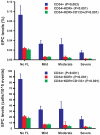Decreased circulating endothelial progenitor cell levels and function in patients with nonalcoholic fatty liver disease
- PMID: 22359630
- PMCID: PMC3280999
- DOI: 10.1371/journal.pone.0031799
Decreased circulating endothelial progenitor cell levels and function in patients with nonalcoholic fatty liver disease
Abstract
Objectives: Nonalcoholic fatty liver disease (NAFLD) is associated with advanced atherosclerosis and a higher risk of cardiovascular disease. Increasing evidence suggests that injured endothelial monolayer is regenerated by circulating bone marrow derived-endothelial progenitor cells (EPCs), and levels of circulating EPCs reflect vascular repair capacity. However, the relation between NAFLD and EPC remains unclear. Here, we tested the hypothesis that patients with nonalcoholic fatty liver disease (NAFLD) might have decreased endothelial progenitor cell (EPC) levels and attenuated EPC function.
Methods and results: A total of 312 consecutive patients undergoing elective coronary angiography because of suspected coronary artery disease were screened and received examinations of abdominal ultrasonography between July 2009 and November 2010. Finally, 34 patients with an ultrasonographic diagnosis of NAFLD, and 68 age- and sex-matched controls without NAFLD were enrolled. Flow cytometry with quantification of EPC markers (defined as CD34(+), CD34(+)KDR(+), and CD34(+)KDR(+)CD133(+)) in peripheral blood samples was used to assess circulating EPC numbers. The adhesive function, and migration, and tube formation capacities of EPCs were also determined in NAFLD patients and controls. Patients with NAFLD had a significantly higher incidence of metabolic syndrome, previous myocardial infarction, hyperuricemia, and higher waist circumference, body mass index, fasting glucose and triglyceride levels. In addition, patients with NAFLD had significantly decreased circulating EPC levels (all P<0.05), attenuated EPC functions, and enhanced systemic inflammation compared to controls. Multivariate logistic regression analysis showed that circulating EPC level (CD34(+)KDR(+) [cells/10(5) events]) was an independent reverse predictor of NAFLD (Odds ratio: 0.78; 95% confidence interval: 0.69-0.89, P<0.001).
Conclusions: NAFLD patients have decreased circulating EPC numbers and functions than those without NAFLD, which may be one of the mechanisms to explain atherosclerotic disease progression and enhanced cardiovascular risk in patients with NAFLD.
Conflict of interest statement
Figures




Similar articles
-
Metabolic syndrome and nonalcoholic fatty liver disease. The role of endothelial progenitor cells.Ann Hepatol. 2013 Nov-Dec;12(6):908-14. Ann Hepatol. 2013. PMID: 24114821
-
Impact of glycemic control on circulating endothelial progenitor cells and arterial stiffness in patients with type 2 diabetes mellitus.Cardiovasc Diabetol. 2011 Dec 20;10:113. doi: 10.1186/1475-2840-10-113. Cardiovasc Diabetol. 2011. PMID: 22185563 Free PMC article.
-
Burden of carotid atherosclerosis in patients with stroke: relationships with circulating endothelial progenitor cells and hypertension.J Hum Hypertens. 2007 Jun;21(6):445-51. doi: 10.1038/sj.jhh.1002178. Epub 2007 Mar 15. J Hum Hypertens. 2007. PMID: 17361211
-
Dysfunctional endothelial progenitor cells in metabolic syndrome.Exp Diabetes Res. 2012;2012:585018. doi: 10.1155/2012/585018. Epub 2011 Sep 19. Exp Diabetes Res. 2012. PMID: 21941528 Free PMC article. Review.
-
The impact of different forms of exercise on circulating endothelial progenitor cells in cardiovascular and metabolic disease.Eur J Appl Physiol. 2022 Apr;122(4):815-860. doi: 10.1007/s00421-021-04876-1. Epub 2022 Jan 12. Eur J Appl Physiol. 2022. PMID: 35022875 Free PMC article. Review.
Cited by
-
Endothelial Progenitor Cells Dysfunctions and Cardiometabolic Disorders: From Mechanisms to Therapeutic Approaches.Int J Mol Sci. 2021 Jun 22;22(13):6667. doi: 10.3390/ijms22136667. Int J Mol Sci. 2021. PMID: 34206404 Free PMC article. Review.
-
An Integrated Platform for Isolation, Processing, and Mass Spectrometry-based Proteomic Profiling of Rare Cells in Whole Blood.Mol Cell Proteomics. 2015 Jun;14(6):1672-83. doi: 10.1074/mcp.M114.045724. Epub 2015 Mar 9. Mol Cell Proteomics. 2015. PMID: 25755294 Free PMC article.
-
New insights into the association between non-alcoholic fatty liver disease and atherosclerosis.Ann Transl Med. 2019 Dec;7(Suppl 8):S300. doi: 10.21037/atm.2019.11.13. Ann Transl Med. 2019. PMID: 32016019 Free PMC article. No abstract available.
-
Endothelial progenitor cell dysfunction in acute exacerbation of chronic obstructive pulmonary disease.Mol Med Rep. 2017 Oct;16(4):5294-5302. doi: 10.3892/mmr.2017.7260. Epub 2017 Aug 16. Mol Med Rep. 2017. PMID: 28849108 Free PMC article.
-
Cardiovascular Risk Reduction in Patients with Nonalcoholic Fatty Liver Disease: The Potential Role of Ezetimibe.Dig Dis Sci. 2016 Dec;61(12):3425-3435. doi: 10.1007/s10620-016-4330-z. Epub 2016 Oct 6. Dig Dis Sci. 2016. PMID: 27714510 Review.
References
-
- Adams LA, Angulo P. Recent concepts in non-alcoholic fatty liver disease. Diabet Med. 2005;22(9):1129–1133. - PubMed
-
- Lonardo A, Bellini M, Tartoni P, Tondelli E. The bright liver syndrome. Prevalence and determinants of a “bright” liver echopattern. Ital J Gastroenterol Hepatol. 1997;29(4):351–356. - PubMed
-
- el-Hassan AY, Ibrahim EM, al-Mulhim FA, Nabhan AA, Chammas MY. Fatty infiltration of the liver: analysis of prevalence, radiological and clinical features and influence on patient management. Br J Radiol. 1992;65(777):774–778. - PubMed
-
- Fan JG, Zhu J, Li XJ, Li L, Dai F, et al. Prevalence of and risk factors for fatty liver in a general population of Shanghai, China. J Hepatol. 2005;43(3):508–514. - PubMed
-
- Tarantino G, Saldalamacchia G, Conca P, Arena A. Non-alcoholic fatty liver disease: further expression of the metabolic syndrome. J Gastroenterol Hepatol. 2007;22(3):293–303. - PubMed
Publication types
MeSH terms
LinkOut - more resources
Full Text Sources
Medical
Research Materials

